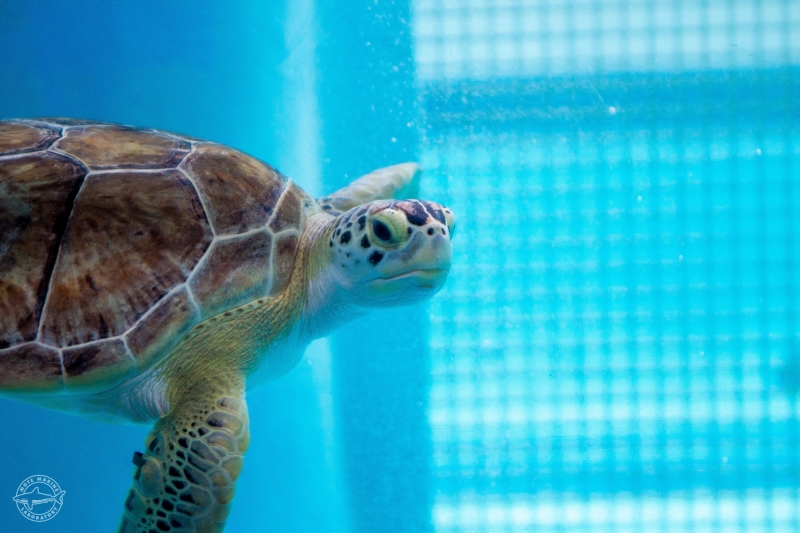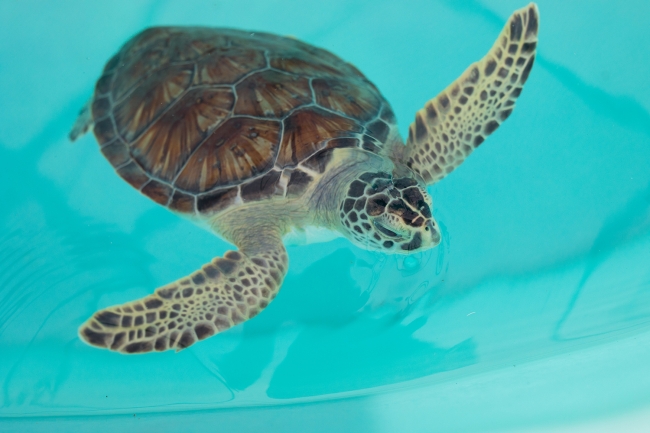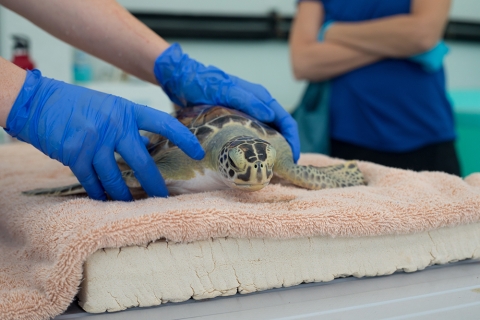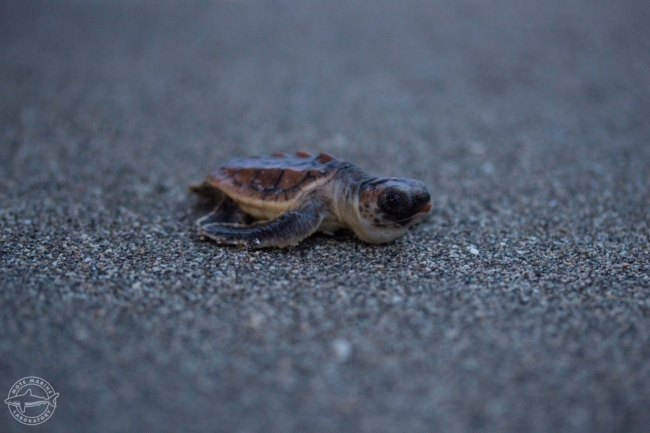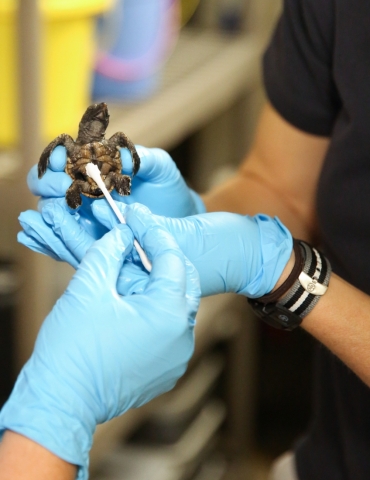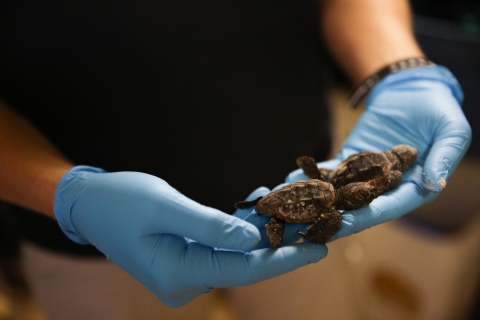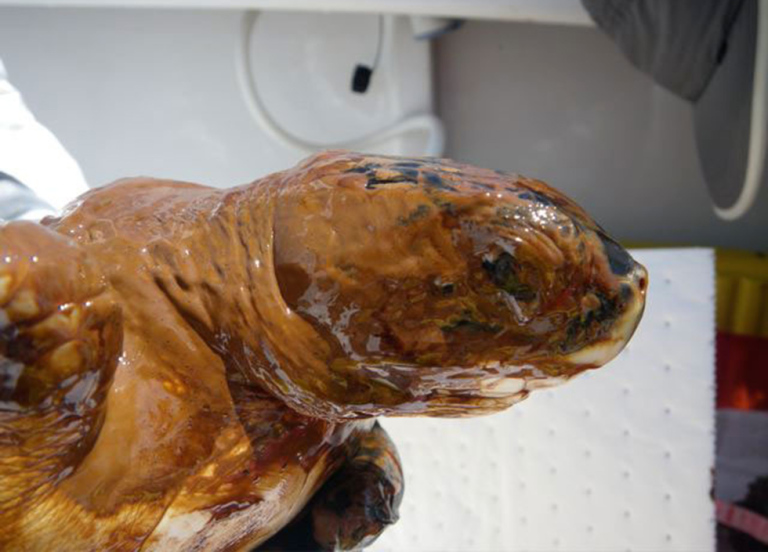
Sea turtles were among the many marine life affected by the 2010 Deepwater Horizon oil spill. During the spill response, OR&R worked with nonprofits, scientists, and volunteers to help rescue sea turtles. Our various partners were able to save about 450 oiled sea turtles that were rescued, cleaned, rehabilitated, and released back into the wild. They also translocated nearly 300 nests and collected 28,000 sea turtle eggs.
Mote Marine Laboratory was instrumental in the sea turtle rescue efforts and in honor of World Sea Turtle Day, June 16, Mote is excited to share some of the other work they do with sea turtles through their Sea Turtle Conservation & Research Program. Find out more about Mote’s work to monitor and protect nesting activity in southwest Florida — a hotspot for loggerhead sea turtles — in this day-in-the-life blog by Mote Senior Biologist Melissa Bernhard.
A day on the nesting beach
Friday, May 25, 2018 began like any other day. My alarm went off at 5:30 a.m., and I rolled groggily out of bed. After dressing in my Sea Turtle Patrol shirt and shorts, I filled two large water bottles and threw them into a cooler. After a quick breakfast, I grabbed a granola bar to snack on later. Each day is different, and we never know what the turtles are going to bring us, so being over-prepared with water and snacks is always a good idea. With my cooler, sunglasses, and trusty beach-resistant flip phone in hand, I headed out into the dark.
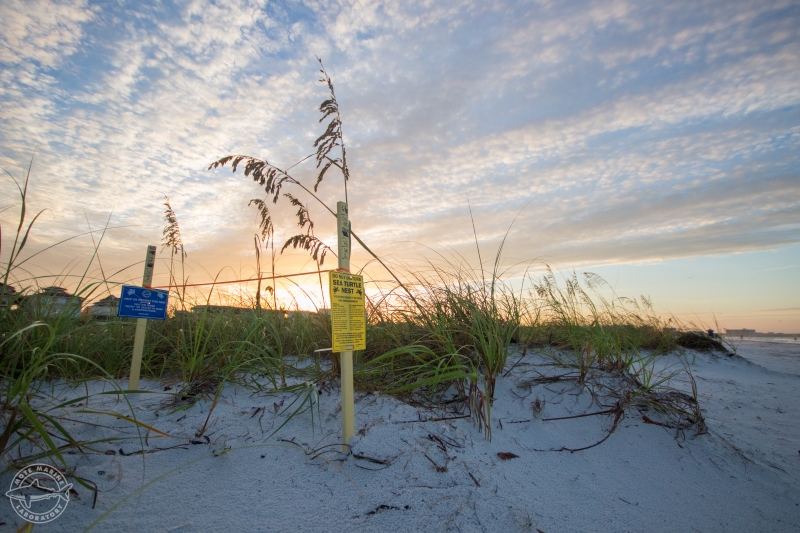
The sky began to brighten as I drove to a public beach where I would meet my two interns and await calls from our nest-finding volunteers. The volunteers were already walking one of seven zones on my assigned beach. Every morning in May through October, they walk the waterline looking for new sea turtle crawls, checking the existing nests, and reporting back so the interns and I can efficiently respond to turtle activities.
At 6:45 a.m., we received our first report from a volunteer who found no new activities on the public beach. This was my signal to call for clearance, allowing Sarasota County staff to begin driving their carts on the beach to start their daily duties such as picking up trash, knowing that they wouldn’t be disturbing unmarked nests.
By 7:15 a.m., I received all but one expected volunteer call, reporting a total of seven nests. We split up to get the activities marked and documented and get out of the hot, Florida sun as quickly as possible. I took the newer intern with me to three nests grouped near each other. We parked and geared up — our backpacks containing clipboards with datasheets, handheld GPS units, markers, mallets, measuring tapes, flagging tape, and, of course, our trustworthy manual and address sheets, which are useful for reminding us of the complex protocols that can vary based on where the activities were. In addition to our hefty backpacks, we also grabbed six 3- to 4-foot yellow stakes for marking off nests.
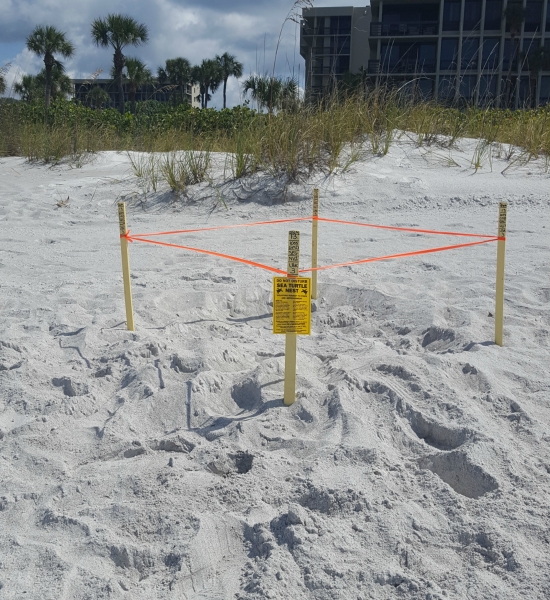
Fortunately, we didn’t have to walk far before we spotted the bright pink flags placed by the volunteers. The flags help beachgoers avoid stepping on the crawls and make them more visible to us from down the beach. We arrived at a nest and visually analyzed the crawl. A lot can be determined just by looking at a sea turtle crawl. First and foremost, we wanted to determine what species created the crawl. Based on the alternating, comma-shaped flipper marks, it was clearly a loggerhead nest, which was unsurprising as loggerhead sea turtles account for more than 99 percent of the nesting activities in our area. After determining the species, we had to determine if the activity was truly a nest. Again, based on visual characteristics, we agreed with the volunteer’s call and decided to document the activity as a nest.
Naturally, about half the time a turtle emerges from the ocean, the crawl does not result in a nest. These crawls, where the turtle abandons her nesting attempt without depositing eggs, are called non-nesting emergences (NNE) or false crawls. Because we decided this was a nest, we needed to collect all the appropriate data, including its location by address, GPS coordinates, and distance from the water or dune. We placed our stakes around the nest by hammering them into the sand with rubber mallets.
Of the thousands of nests we document each year, we monitor a representative sample of them all the way through their hatch. None of today’s nests were going to be included in our sample, but we still staked them off to protect the eggs from beachgoers, and in some places, beach rakers who groom the beaches mechanically. The nests were labelled with a nest ID, which is a unique identifier, so we can link any additional information to its specific nest. Each of the 4,500 nests that we anticipate having on our beaches this summer has a unique nest ID. The second and third nests we documented were also loggerheads.
We spent a bit of time talking with members of the public who were concerned about the proximity of the nests to the water. I explained to them that the turtles have been nesting on these beaches for a long time and we try not to interfere with nature. I also explained that sea turtle eggs are very sensitive to rotation, so moving nests, even this early in incubation, can be very detrimental to their survival.
Quite a few factors play into the success of the nests, and some affect but don’t kill the eggs. For example, sea turtles have temperature-dependent sex determination, which means that higher incubation temperatures yield female-dominated nests, while lower incubation temperatures produce nests with more males. These beachgoers said they understood and asked if I was concerned about the impending storm that was supposed to head our way over the weekend. I agreed that if the storm came our way, the nest would likely experience the effects of high surf, which can include surf overwashing the nest or some or all of the eggs washing out — though the eggs can tolerate some level of water exposure, and the damage caused by moving the nests could be greater than what they experience from the water.
Before they walked away, I also reminded them that nesting will continue into August. Each female that comes to nest on our beaches will lay around five or six nests, over a month or two. She does this to hedge her bets against various threats including storms, so if one, two, or even three of her nests wash out, she still has several more nests left to hatch, each averaging about 100 eggs. This information seemed to cheer the beachgoers up and they thanked me for the information and for protecting their local turtles. No matter how many times I hear it, it always feels good to be appreciated by the local residents who care about the turtles on their beach.
There was only one more nest to mark up, but first we had to deal with an existing nest that was disturbed by a predatory animal, known as depredating. According to the volunteer, this nest had been dug into by a coyote — the first case this year. This time, we didn’t even need the volunteer’s flags to guide us to the location. As we stepped on the beach, we could see a nest with four or five black crows standing around taking advantage of the exposed eggs. As we walked up, the crows flew away. We were able to tell it was a coyote that originally depredated the nest due to the presence of the dog-like paw prints and digging pattern. Broken egg shells were scattered for about 10 feet away from the nest.
This nest was part of our monitored sample for detailed data collection, so as we collected the egg shells, we counted how many were destroyed by the coyote: 56. We also noted that crows were present. This will help us to better interpret the data because crows often will carry eggs away from the nest, which makes getting an accurate count difficult. After removing the destroyed eggs, we also gathered any gooey/yolky sand. All of the depredated contents were then buried away from the nest near the waterline to try to keep all the egg smells away from the remaining eggs and avoid attracting more predators.
By the time we walked up to the final nest, I was convinced that it was going to be a false crawl. There had already been seven nests on the island and no false crawls, which is a lot different than the expected 1-to-1 ratio. Much to my surprise, it was a beautiful, very obvious nest. At this point, we had been reunited with the other intern and the three of us were able to crank out the data collection and staking quickly, like a well-oiled machine, before heading back to our cars. It was now 9:30 a.m., and we planned to reconvene at the office with other staff members on other islands for data entry and next-day planning.
Today was just one of 200 days per year when we patrol 35 miles of beach looking for sea turtle activity. If this year is anything like the last two years, we expect to have around 4,500 nests on our beaches by the end of the season. But anything could happen. Twice in the last decade, nesting numbers in our area have doubled from one year to the next, and state-wide, loggerhead nesting has been increasing in recent years. We believe the efforts put in to conservation programs like ours that began 37 years ago are starting to pay off. The turtles that hatched from those first nests that were protected are beginning to reach maturity and return to their native beaches to lay their own nests.
Part of a bigger picture
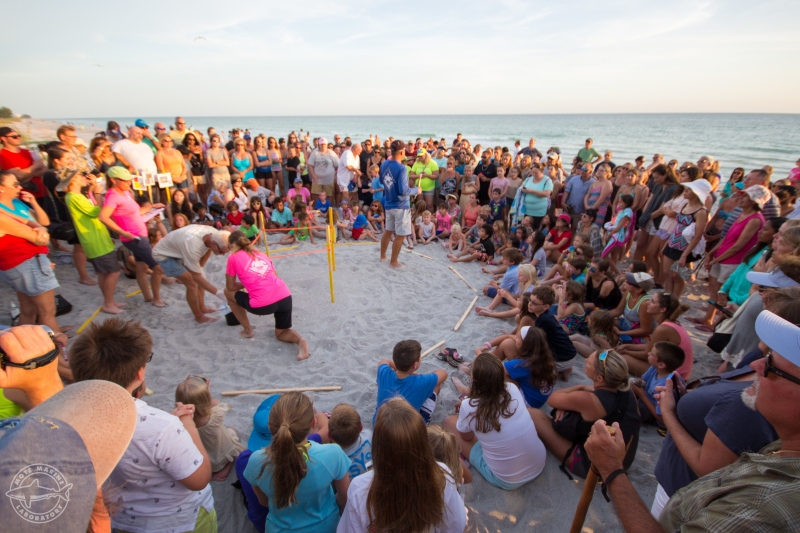
Bernhard and her Mote colleagues are part of a statewide, team effort to monitor sea turtle nesting.
Florida Fish and Wildlife Conservation Commission's Fish and Wildlife Research Institute coordinates and permits nesting beach monitoring and compiles data from about 215 beaches in the Statewide Nesting Beach Survey, including about 36 beaches in the more rigorous Index Nesting Beach Survey. The latter survey standardizes data collection through consistent effort by location, fixed dates, and specialized annual training of beach surveyors.
At the local level, data from sea turtle monitoring programs helps city and county officials implement and update local sea turtle protection ordinances. For instance, the town of Longboat Key consulted Mote’s research data and requested Mote scientists' interpretation of the data during their effort to draft a new ordinance, which was adopted by the town’s commission to improve on existing protections for sea turtles.
You are part of the solution
Many people approach Sea Turtle Patrollers on the beach, and we like to share what we’re doing, explain why sea turtle conservation matters, and how to help. Beyond walking the beach, we provide educational materials for over 200 local properties each year!
If you live, work, or recreate on sea turtle nesting beaches, please keep them turtle-friendly by following these guidelines throughout your local nesting season:
Do:
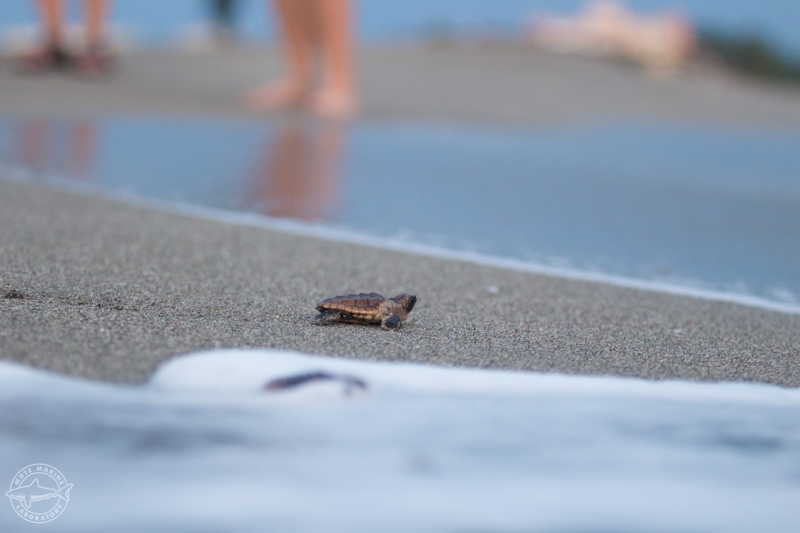
- If you encounter a nesting turtle or hatchlings, remain quiet and observe from a distance.
- Shield or turn off outdoor lights that are visible on the beach from May through October — artificial lights visible from the beach can disorient and attract sea turtles, particularly hatchlings that should be crawling toward the water.
- Close drapes after dark.
- Stack beach furniture at the dune line, or ideally, remove it from the beach.
- Fill in holes that may entrap hatchlings on their way to the water.
Do not:
- Approach nesting turtles or hatchlings, make noise, or shine lights at turtles.
- Use flashlights or fishing lamps on the beach.
- Encourage a turtle to move while nesting or pick up hatchlings that have emerged and are heading for the water.
- Use fireworks on the beach.
Find out more about Mote's Sea Turtle Conservation & Research Program on the Mote Marine Laboratory website.
Mote Senior Biologist Melissa Bernhard oversees staff, interns and about 300 volunteers who monitor sea turtle nesting beaches on Longboat Key through Venice every day of nesting season, May 1-Oct. 31. She and her colleagues in Mote’s Sea Turtle Conservation & Research Program mark sea turtle nests with stakes, collect a suite of data to benefit conservation and management, and educate the public about turtle-friendly practices. Their activities take place under a marine turtle permit from the Florida Fish & Wildlife Conservation Commission (FWC), and form an important piece in the statewide puzzle of sea turtle conservation.
